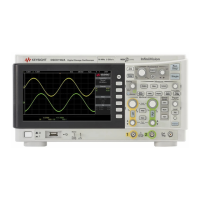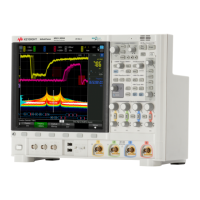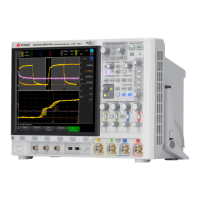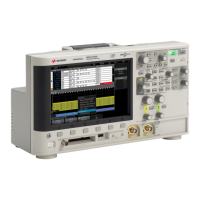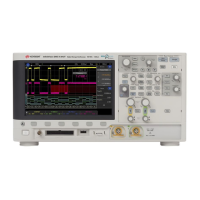1236 Keysight InfiniiVision 4000 X-Series Oscilloscopes Programmer's Guide
34 :WAVeform Commands
There are four types of waveform acquisitions that can be selected for analog
channels with the :ACQuire:TYPE command (see page 276): NORMal, AVERage,
PEAK, and HRESolution. Digital channels are always acquired using NORMal.
When the data is acquired using the :DIGitize command (see page 235) or :RUN
command (see page 256), the data is placed in the channel buffer of the specified
source.
Once you have acquired data with the :DIGitize command, the instrument is
stopped. If the instrument is restarted (via the programming interface or the front
panel), or if any instrument setting is changed, the data acquired with the :DIGitize
command may be overwritten.You should first acquire the data with the :DIGitize
command, then immediately read the data with the :WAVeform:DATA? query (see
page 1243) before changing any instrument setup.
A waveform record consists of either all of the acquired points or a subset of the
acquired points. The number of points acquired may be queried using
:ACQuire:POINts? (see page 268).
Helpful Hints:
The number of points transferred to the computer is controlled using the
:WAVeform:POINts command (see page 1246). If :WAVeform:POINts MAXimum is
specified and the instrument is not running (stopped), all of the points that are
displayed are transferred. This can be as many as 4,000,000 in some operating
modes or as many as 8,000,000 for a digital channel on the mixed signal
oscilloscope. Fewer points may be specified to speed data transfers and minimize
controller analysis time. The :WAVeform:POINts may be varied even after data on a
channel is acquired. However, this decimation may result in lost pulses and
transitions. The number of points selected for transfer using :WAVeform:POINts
must be an even divisor of 1,000 or be set to MAXimum. :WAVeform:POINts
determines the increment between time buckets that will be transferred. If POINts
= MAXimum, the data cannot be decimated. For example:
•
:WAVeform:POINts 1000 — returns time buckets 0, 1, 2, 3, 4 ,.., 999.
•
:WAVeform:POINts 500 — returns time buckets 0, 2, 4, 6, 8 ,.., 998.
•
:WAVeform:POINts 250 — returns time buckets 0, 4, 8, 12, 16 ,.., 996.
•
:WAVeform:POINts 100 — returns time buckets 0, 10, 20, 30, 40 ,.., 990.
Analog Channel Data
NORMal Data
Normal data consists of the last data point (hit) in each time bucket. This data is
transmitted over the programming interface in a linear fashion starting with time
bucket 0 and going through time bucket n - 1, where n is the number returned by
the :WAVeform:POINts? query (see page 1246). Only the magnitude values of
each data point are transmitted. The first voltage value corresponds to the first
time bucket on the left side of the screen and the last value corresponds to the
